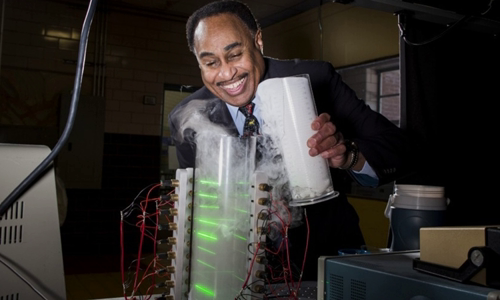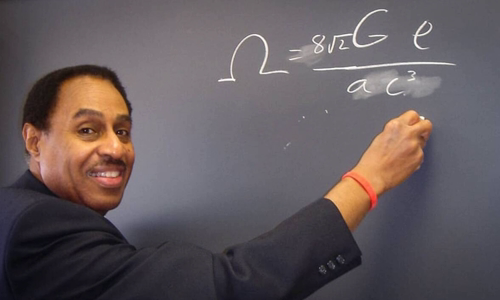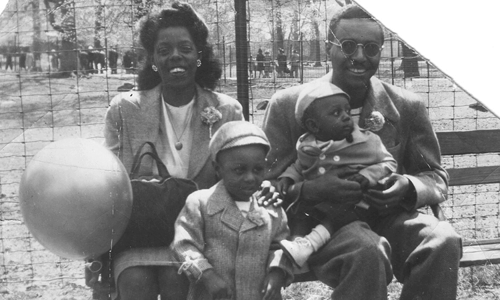America Going back to the past for many people is unthinkable, but Ron Mallett is gradually realizing this ambition to meet his lost father.
American astrophysicist Ron Mallett is one of the few people who believes in the ability to go back in time to the past. He has spent most of his life proving that time travel is possible and wants to fulfill his dream of going back to see his father.

Ron Mallett performs experiments in a research lab in Connecticut, USA Photo: CNN.
Mallett's father died suddenly of a heart attack when he was 10 years old and this changed his whole life. "For me, he is the most important person in the world, the center of everything. Although many years have passed, I still do not accept this truth," Mallett said.
Father Mallett, a TV repairman, was the one who instilled in him a love of reading and a passion for scientific research. About a year after his father's death, he accidentally read a classic science fiction novel called "Time Machine" and, according to him, "the book changed my life." Thanks to the imagination of writer H.G Wells, Mallett realized his family tragedy was not the end but the starting point.
At age 74, Mallett is now a professor of physics at the University of Connecticut. He spent his entire career studying black holes and general relativity, the famous theories of space, time, and gravity that Albert Einstein once discovered. Mallett also proposed the theory of time travel in the process of studying time machines.
Although far away from his destination and some even think that he cannot reach his destination, his journey has created the story of the power of love, childhood dreams and people's desire to embrace it. destiny in the universe.
Mallett first came across the concept of time travel in the 1950s. "At that time we didn't even travel to space and people were not sure if it was possible," Mallett recalls.
Growing up in the Bronx district of New York City, USA and later moving to Pennsylvania, the Mallett family struggled to make money. Claiming to be "book aficionados," Mallett still finds ways to satisfy his passion for reading at the Salvation Army bookstore in the neighborhood. It was here that Mallett came across many of Einstein's works, his next important inspiration.
He continued to work hard on science books throughout his teenage years. After finishing high school, he plans to go to college through the G.I. He joined and served 4 years in the US Air Force. Afterwards, Mallett returned to his studies, earning a bachelor's degree in physics, a master's degree, and a doctorate in Einstein's theory.
His first job was at United Technologies, an aircraft manufacturer in Connecticut, where he studied using lasers to drill holes in jet engine blades. After several years of applying mathematical theory to practical work, Mallett joined the University of Connecticut (UCONN) as a professor of physics.
During those years, Mallett was quietly studying the possibility of time travel. He began to publicize his ambition when UCONN appointed him as a full-time professor, a position that allowed him to work freely without fear of dismissal.
"I want to make sure I reach the peak of my professional career, even if it's a little reluctant," Mallett said. He is aware of the prejudice about "crazy professor" and wants to make sure his ambition does not become a joke and threaten the job.

Ron Mallett stood by the recipe chart at a lab in Connecticut, USA Photo: CNN.
But when Mallett began publicly talking about the idea of time travel, he found a common voice with many people and realized that returning to the past was the desire of many. According to Mallett, we all have regrets, decide whether we want to change or someone wants to see us again. "People from many parts of the world contacted me to ask about the possibility of going back in time," he said.
Mallett said all his ideas revolved around special relativity (special) and Einstein's general theory of relativity. "To put it simply, Einstein thought that time could be affected by velocity," said Mallett.
He gave an example of a space astronaut rocket flying close to the speed of light. Time on Earth and on rockets will vary. "When they return they may think they are only a few years old, but decades have passed on Earth," Mallett said.
Mallet also gave an example of the classic science fiction film 1968, "Planet Monkey", in which astronauts realized that they had not been to a distant monkey planet but had come to Earth in the future. So - the moment humans were conquered monkey.
"That's the exact representation of Einstein's general theory of relativity. According to this theory, if you move fast enough, you can go through time. And that's time travel," Mallettt said. However, it is going to the future while Mallett wants to return to the past. Could this theory help him fulfill his desire to meet his father?
"According to Einstein's theory, the greater the gravity, the slower time passes," Mallett said. Einstein argued that gravity was not really a force, but a warping of space with a large object. "If you can bend space, you can go through it," he said.
"According to Einstein, what we call space is also related to time, which is why it is called space - time. Whatever happens in space affects time", he added.
According to Mr. Mallett, by "twisting" time into a pipe, one can go from the future to the past and back to the future. This is the idea of a "wormhole", a theoretical path through space - time that can form a shortcut for long distances through the universe.
Mallett also thinks that light can be used to influence time through a ring laser. He created a prototype that illustrates the use of a laser to create a circulating light beam that twists space and time.
"The knowledge of lasers in my first job helped me make a breakthrough to find out how to build the basis of the time machine. Studying the type of gravitational field generated by a ring laser could lead to a new perspective." about the ability to create a time machine based on a circulating light beam, "Mallett said.

Ron Mallett (standing) in a picture taken with his parents and younger brother in Bronx Park, New York, 1950s Photo: CNN.
Mallett also has a theoretical formula to prove this. "The light beam can eventually act as a time machine and create a spiral of time that allows you to return to the past," he said. However, it also has disadvantages. "You can send the information back, but it is only up to the time you boot up," he said.
However, not everyone agrees with Mallett. "Past travel only allows us to understand gravity in general relativity," said Paul Sutter, astrophysicist and broadcaster of the podcast called "Ask." a Spaceman, "said. "But every time we try to build a time machine, there are other physical principles that will ruin that."
Sutter said he knew what Mallett was after and found it interesting if it didn't necessarily work at all costs. "I don't think it necessarily has to work, because there are still a lot of holes in his work. Therefore, the actual device seems to be hard to achieve," Sutter said.
In 2005, Ken D. Olum and Allen Everett of the Institute of Cosmology, Department of Physics and Astronomy, Tuffs University severely criticized Mallett's idea. They say that found a flaw in Mallett's equation and the practicality of the device he proposed.
British scientific writer Brian Clegg took a better view of Mallett's idea. He wrote about this scientist in his book "How to create a time machine". "Not everyone agrees with the machine he wants to create, but I think it's an interesting proposal worth testing. If it works even if it's not a real time machine, it still can produce a small but powerful demonstration of his principles, "Clegg said.
Mallett quickly proved his idea with a theoretical basis. He said he was trying to raise funds to conduct a field trial. "It's not like the movie. It doesn't happen and ends after two hours at the price you pay to watch the movie. It will be worth it," Mallett said.
Comparing with cinema is a common theme in conversation with Mallett. He likes to interpret the concept of time travel through the film example. When asked about the ethical side of going back in time, he said that international rules and policies are needed, such as in the 1994 movie called "Timecop", in which Jan-Claude Van Damme plays a role. employees working for time travel operators.
Another example is Christopher Nolan's 2014 film "Interstellar", which refers to the time affecting humans in a different universe from Earth. The scientific knowledge of this film is provided by the award-winning theoretical physicist Kip Thorne. But Mallet also appreciated the emotional element of the film. He praised it as a touching story about father and daughter.
Hollywood had called Mallett several times to propose an adaptation of the autobiography "Time Traveler", which he co-wrote in 2008. However, the proposal failed despite the presence of the famous director Spike Lee. Mallett said a major production company has now copyrighted his story and is working on another film project.
Despite spending his whole life studying time travel, Mallett probably couldn't really return to New York in the 1950s. But thanks to the magic of film, he was able to get a glimpse of the past, Or we can say "strange country" to meet our father for the last time.
"The idea of meeting my father in the movie could help bring him back to me again," Mallet said.



 AngelaEstherHalder
AngelaEstherHalder







